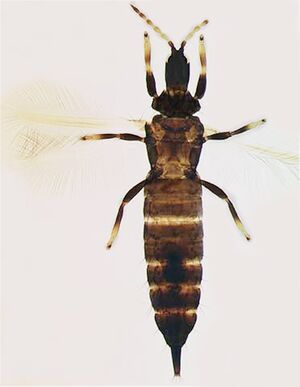Difference between revisions of "Liothrips (Liothrips) vaneeckei"
| Line 3: | Line 3: | ||
== Nomenclatural details == | == Nomenclatural details == | ||
''Liothrips vaneeckei'' Priesner, 1920: 211. | ''Liothrips vaneeckei'' Priesner, 1920: 211. | ||
| + | |||
| + | ''Liothrips chinensis'' Han, 1997: 559, 569 (in English). Synonymised by Dang et al., 2024: 80 | ||
| + | |||
| + | ''Liothrips diwasabiae'' Han, 1997: 562, 570 (in English). Synonymised by Dang et al., 2024: 80 | ||
| + | |||
| + | ''Liothrips sanxiaensis'' Han, 1997: 563, 570 (in English). Synonymised by Dang et al., 2024: 80 | ||
| + | |||
| + | ''Liothrips sinarundinariae'' Han, 1997: 564, 570 (in English). Synonymised by Dang et al., 2024: 80 | ||
== Biology and Distribution == | == Biology and Distribution == | ||
| − | Described from the Netherlands. Recorded from Japan and New Zealand. Widespread in the holarctic. Occurs under scales of lily bulbs (Okajima, 2006); see also | + | Described from the Netherlands. Recorded from Japan and New Zealand. Widespread in the holarctic. Occurs under scales of lily bulbs (Okajima, 2006); see also Mound ''et al''. 2023. ''chinensis'', ''diwasabieae'' and ''sanxiaensis'' described from Liziping, China; ''sanxiaensis'' from from Xingshan Co., China. |
== References == | == References == | ||
Priesner H (1920) Ein neuer ''Liothrips'' (Uzel)(Ord. Thysanoptera) aus den Niederlanden. ''Zoologische Mededeelingen Rijks Museet Leiden'' 5: 211–212. | Priesner H (1920) Ein neuer ''Liothrips'' (Uzel)(Ord. Thysanoptera) aus den Niederlanden. ''Zoologische Mededeelingen Rijks Museet Leiden'' 5: 211–212. | ||
| + | |||
| + | Han YF (1997) Thysanoptera: Aeolothripidae, Thripidae, Phlaeothripidae. pp 531-571 in Yang Xing-Ke [eds] ''Insects of the Three Gorge Reservoir Area of Yangtze River''. Chongqing Press, Chongqing. | ||
Okajima S (2006) ''The Insects of Japan. Volume 2. The suborder Tubulifera (Thysanoptera)''. Fukuoka : Touka Shobo Co. Ltd. pp. 1–720. | Okajima S (2006) ''The Insects of Japan. Volume 2. The suborder Tubulifera (Thysanoptera)''. Fukuoka : Touka Shobo Co. Ltd. pp. 1–720. | ||
| Line 13: | Line 23: | ||
== Type information == | == Type information == | ||
| − | Male & female syntypes in Senckenberg Museum, Frankfurt. | + | Male & female syntypes in Senckenberg Museum, Frankfurt; Han types in Institute of Zoology, Academia Sinica, Beijing. |
[[category: Liothrips (Liothrips) species]][[category: Phlaeothripinae species]][[category:Thysanoptera species extant]] | [[category: Liothrips (Liothrips) species]][[category: Phlaeothripinae species]][[category:Thysanoptera species extant]] | ||
Latest revision as of 01:01, 27 August 2025
Nomenclatural details
Liothrips vaneeckei Priesner, 1920: 211.
Liothrips chinensis Han, 1997: 559, 569 (in English). Synonymised by Dang et al., 2024: 80
Liothrips diwasabiae Han, 1997: 562, 570 (in English). Synonymised by Dang et al., 2024: 80
Liothrips sanxiaensis Han, 1997: 563, 570 (in English). Synonymised by Dang et al., 2024: 80
Liothrips sinarundinariae Han, 1997: 564, 570 (in English). Synonymised by Dang et al., 2024: 80
Biology and Distribution
Described from the Netherlands. Recorded from Japan and New Zealand. Widespread in the holarctic. Occurs under scales of lily bulbs (Okajima, 2006); see also Mound et al. 2023. chinensis, diwasabieae and sanxiaensis described from Liziping, China; sanxiaensis from from Xingshan Co., China.
References
Priesner H (1920) Ein neuer Liothrips (Uzel)(Ord. Thysanoptera) aus den Niederlanden. Zoologische Mededeelingen Rijks Museet Leiden 5: 211–212.
Han YF (1997) Thysanoptera: Aeolothripidae, Thripidae, Phlaeothripidae. pp 531-571 in Yang Xing-Ke [eds] Insects of the Three Gorge Reservoir Area of Yangtze River. Chongqing Press, Chongqing.
Okajima S (2006) The Insects of Japan. Volume 2. The suborder Tubulifera (Thysanoptera). Fukuoka : Touka Shobo Co. Ltd. pp. 1–720.
Mound LA, Dang LH & Tree DJ (2023) The genus Liothrips (Thysanoptera, Phlaeothripidae) in Australia. Zootaxa 5306 (2): 201–214.
Type information
Male & female syntypes in Senckenberg Museum, Frankfurt; Han types in Institute of Zoology, Academia Sinica, Beijing.
